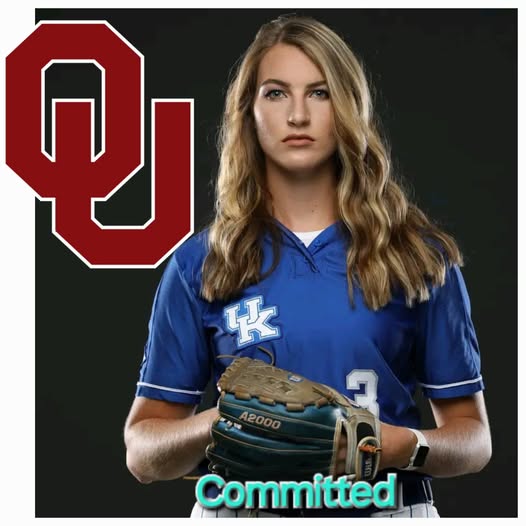Shocking Commitment: Kentucky’s Tatum Spangler Joins Oklahoma Sooners with Four-Year Commitment
In the world of college athletics, recruiting commitments can be as unpredictable as they come. One day a player may be committed to a school, and the next, they’re signing on with another program entirely. However, every so often, a commitment takes everyone by surprise — and Kentucky’s Tatum Spangler’s decision to join the Oklahoma Sooners is one such jaw-dropping moment in recent college football recruiting history.
Spangler, a highly-touted recruit from the state of Kentucky, was widely considered one of the top prospects in his class. His commitment to Oklahoma, a program that has enjoyed unparalleled success in recent years and is about to embark on a new chapter in the SEC, shocked many in the college football world. Not only did Spangler turn heads with his choice to leave his home state and the University of Kentucky behind, but he also made a bold statement by committing to the Sooners for a four-year term — a move that highlights both his dedication and the high expectations he has for himself and for the program that he’s joining.
This commitment signifies not only a personal milestone for Spangler but also a potential turning point for the Oklahoma football program as they prepare for a transition into one of college football’s most competitive conferences. In this article, we’ll break down the importance of Tatum Spangler’s shocking commitment, what it means for the Oklahoma Sooners, and how this bold move could shape both Spangler’s career and the future of Oklahoma football.
Tatum Spangler: The Story So Far
Before diving into the significance of his commitment to Oklahoma, it’s important to understand who Tatum Spangler is and what he brings to the table. A product of a high school football program that has consistently produced top-tier talent, Spangler made a name for himself in Kentucky by showcasing exceptional athleticism, leadership, and a work ethic that set him apart from many of his peers.
Standing 6-foot-4 and weighing 240 pounds, Spangler has the prototypical frame that college football programs covet in a linebacker. His versatility, speed, and football IQ allowed him to excel in multiple positions on the field, from pass rusher to traditional linebacker roles. He’s been praised for his ability to cover ground quickly and deliver powerful hits, making him an asset to any defensive scheme.
As a high school senior, Spangler dominated in nearly every game he played, amassing double-digit sacks, forced fumbles, and countless tackles for loss. His ability to disrupt the opposing offense earned him recognition as one of the nation’s top recruits. Recruited by a host of high-profile programs, including some of the country’s elite SEC and Big Ten schools, Spangler had his pick of top-tier universities. However, in a move that shocked many, he made the decision to commit to the University of Oklahoma, choosing the Sooners over traditional powerhouses like Kentucky, Alabama, and Georgia.
The Shock Factor: Why Spangler’s Decision Was So Unpredictable
Tatum Spangler’s decision to join the Oklahoma Sooners was a shocking turn of events for several reasons. First and foremost, Spangler had long been considered a potential future star at Kentucky, his home state’s flagship university. The Wildcats had been pursuing him for years, and his ties to Kentucky ran deep. His family, friends, and community had all been aligned with the idea of him playing for the Wildcats, and it seemed like a perfect fit given the program’s rising prominence within the SEC.
Additionally, Spangler had been a frequent visitor to Lexington, where he had built strong relationships with the Kentucky coaching staff. Many thought it was only a matter of time before he formally committed to the Wildcats. So, when Spangler suddenly and decisively flipped his commitment to Oklahoma, it sent shockwaves through the college football world.
But beyond the initial surprise, there were other layers to Spangler’s decision that added intrigue. For one, the University of Oklahoma is about to enter a new era of competition as it transitions into the Southeastern Conference (SEC), one of the toughest and most competitive conferences in college football. The SEC is home to football powerhouses such as Alabama, Georgia, and LSU, and many expected that the best recruits would want to play in the conference for the national exposure and championship pedigree.
The timing of Spangler’s commitment to Oklahoma, just as the Sooners are about to make their move into the SEC, adds even more complexity to the story. Many had speculated that top recruits would be hesitant to join Oklahoma during this period of transition, fearing that the program might struggle to compete in the new conference or that it might take some time to adjust to the heightened competition. For Spangler, however, it seems this uncertainty was less of a concern than the opportunity to play for a program with a proven track record of success and a strong coaching staff that was willing to bet on his development.
Furthermore, Spangler’s decision to commit to Oklahoma with a four-year commitment showed a level of confidence and stability that many didn’t expect. In an era where college athletes often jump from one school to another through the transfer portal, Spangler’s commitment to stay for four years represents an unusual but admirable level of loyalty. It speaks to his desire to develop and succeed in a long-term environment, as well as his belief in Oklahoma’s ability to build a championship-contending team.
What Oklahoma Gains from Spangler’s Commitment
Tatum Spangler’s commitment is more than just a single player choosing a program; it’s a statement about where Oklahoma football is heading. This four-year commitment is a clear indication that Spangler believes in the Sooners’ vision, and it’s a significant acquisition for head coach Brent Venables and his staff as they prepare to compete in the SEC.
The Oklahoma defense has long been a strong point of the team, but there’s always room for improvement, especially in the transition to a more physical and competitive conference like the SEC. Spangler, with his athleticism and versatility, provides the Sooners with a dynamic presence in their defensive front seven. His ability to both rush the passer and cover the field in coverage schemes makes him a highly valuable asset to a defense looking to make an immediate impact in the SEC.
Oklahoma’s defensive coaching staff will no doubt be excited to work with Spangler, as his skill set fits perfectly into the scheme that Venables is trying to implement. Venables, who has a rich background as a defensive coordinator at Clemson, is known for developing some of the best defensive units in college football, and Spangler could be an integral part of that effort moving forward.
Spangler’s size and strength make him a player who can contribute both as a linebacker and in an edge rusher role. His versatility allows the Sooners to use him in a variety of different situations, whether it’s as a traditional linebacker in run-stopping situations or as a pass-rusher in obvious passing downs. This kind of flexibility is a prized trait in college football, and it gives the Sooners multiple ways to maximize Spangler’s talents.
The Impact of Spangler’s Commitment on Oklahoma’s Recruiting Strategy
Tatum Spangler’s commitment has the potential to spark a domino effect in Oklahoma’s recruiting strategy. When a player of his caliber — someone who is highly sought after and viewed as a future star — commits to a program, it can help to solidify that program’s reputation and draw in other top-tier recruits. Spangler’s decision to choose Oklahoma over several other elite programs is a testament to the strength of the Sooners’ recruiting efforts, and it sends a message to other recruits that Oklahoma is a program on the rise and ready to compete for national titles.
In the coming months, it’s likely that more recruits will take a closer look at Oklahoma, particularly after seeing Spangler’s commitment and the coaching staff’s ability to secure a top-tier talent. Spangler’s presence on the recruiting trail could also serve as a beacon for other players who might have previously been hesitant about joining a program in transition. The four-year commitment shows that Spangler believes in what Venables and his staff are building, and this message could resonate with other top recruits who want to be a part of something special.
Spangler’s Personal Goals and the Future of Oklahoma Football
For Tatum Spangler, the decision to join Oklahoma was about more than just joining a successful program. It was about aligning himself with a coaching staff and a university that could help him reach his fullest potential both on and off the field. His four-year commitment shows that he’s not looking for a quick fix or a one-and-done opportunity. Instead, he’s committed to a long-term vision of growth and development, and that bodes well for his future as a player.
As the Sooners transition into the SEC, Spangler will have the opportunity to compete against some of the best talent in the country, and he’ll be a key player in helping the Sooners establish themselves as a force to be reckoned with in their new conference. If his commitment is any indication, Spangler’s time at Oklahoma will not only be about personal success but also about contributing to the team’s larger goal of winning championships.



